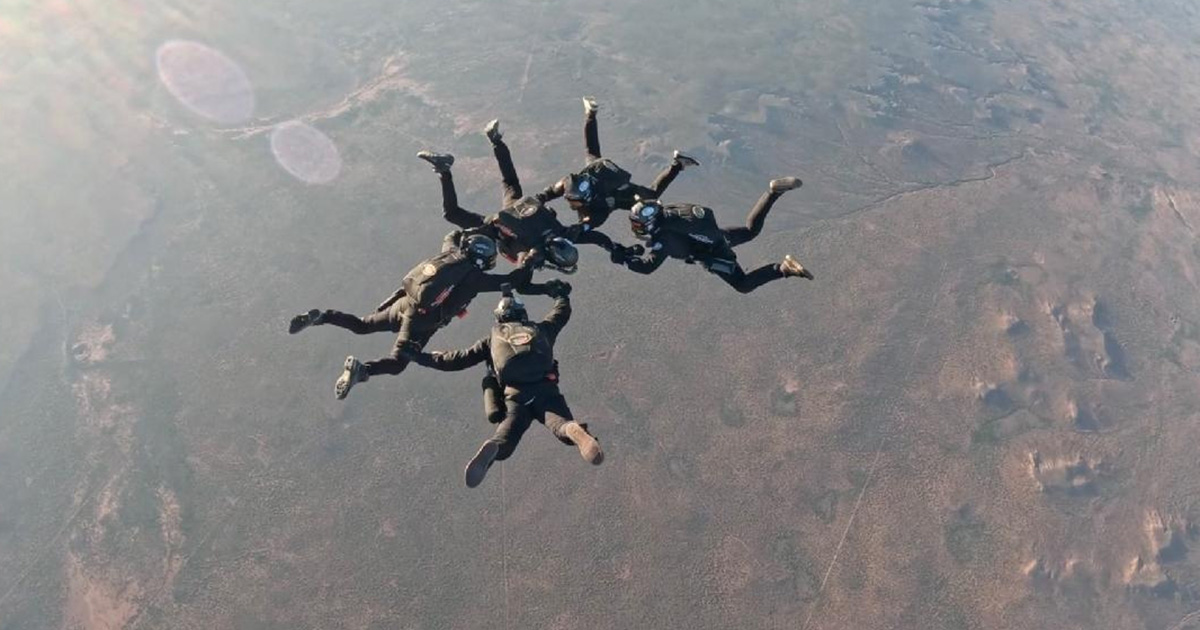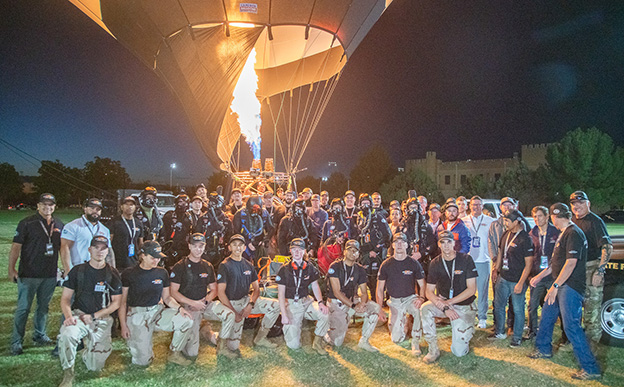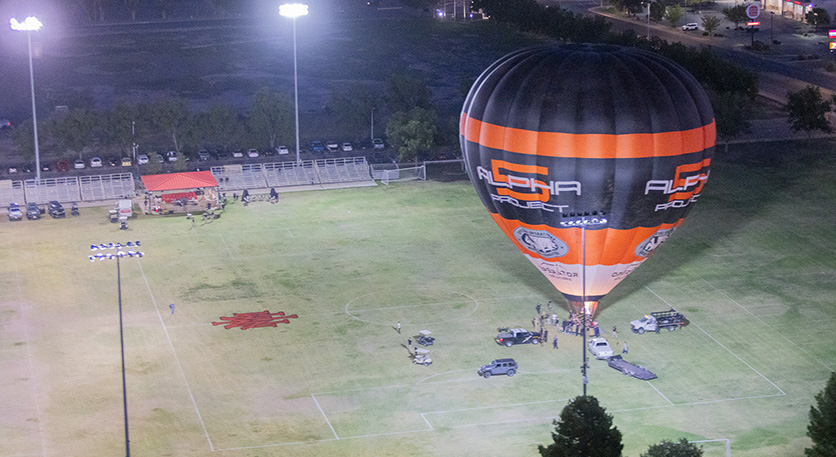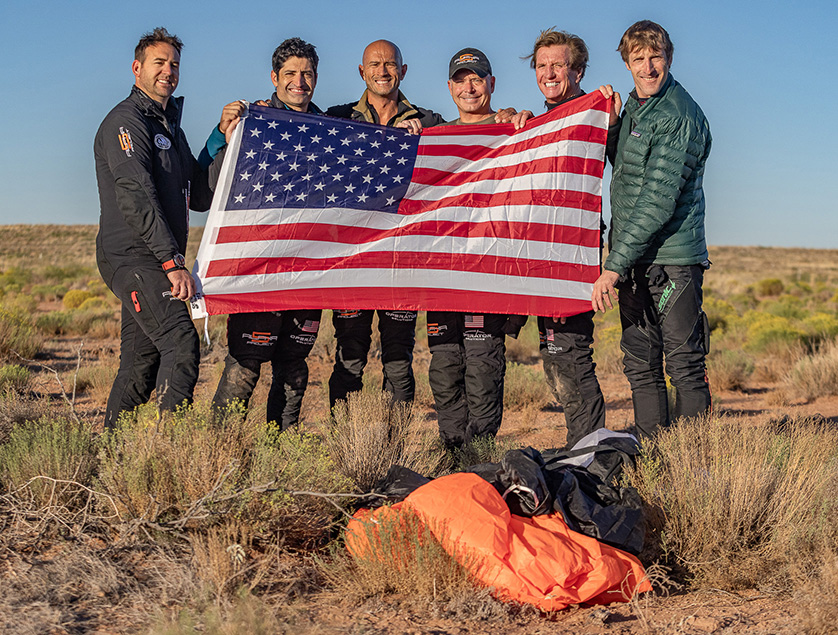Up, Up and Away—The Alpha 5 HALO Formation Skydive
On the morning of Thursday, September 28, five skydivers set a Guinness World Record for the highest HALO formation skydive, jumping from the largest balloon ever manufactured in the United States (roughly 115 feet tall) at 38,067 feet MSL down into the desert near Roswell, New Mexico. The Alpha 5 team consisted of Larry Connor, private astronaut and team captain, as well as four current and former U.S. Air Force Pararescuemen—Brandon Daugherty, Rob Dieguez, Chris Lais and Jimmy Petrolia. The team, along with camera flyer Chris Peterson, oxygen technician Tad Smith and balloon pilot Shane Wallace, prepared and executed the jump in order to raise funds and awareness for Special Operations Warrior Foundation, a nonprofit organization that provides educational and financial support to the families of fallen U.S. military veterans.
After the jump, Connor, Daugherty and Lais sat down for an interview with Parachutist to discuss the preparation process, their successful jump and the causes that motivate them.
Can you tell us about your skydiving backgrounds?
Larry Connor: Back in 1974 or 1975, there was a drop zone here in Ohio, out in Greene County. The guy’s name was Jim West. I went out there and it was static line with an old T-10, and I did maybe 15-20 skydives. And then in 1991, I decided to pick it back up and went down to Wayneville, Ohio [former USPA Group Member Waynesville Sky Sports], and started jumping there. I didn’t get to 100 jumps; I had 99 jumps, and really enjoyed it.
Brandon Daugherty: I’m a U.S. Air Force Pararescueman, coming up on 21 years. I came in shortly after 9/11, and did 10 years active duty, with seven combat deployments. I worked with NASA for six years, developing the astronaut rescue procedures to jump out in the middle of the ocean for rescues. I brought Chris [Lais] on board with me when I did that, and about three years ago, he and I started our own company called Operator Solutions, where we offer that same service that we built for NASA.
Chris Lais: I retired after 24 years in the Air Force, a lot of the time guarding the nation’s nuclear forces. In 2007, I changed over and became a pararescueman, as it was time for new challenges. I did a number of deployments supporting the global war on terror, supporting task force missions. Then, like Brandon said, I joined up with him and started this business. It’s been interesting—been a great time—and doing the Alpha 5 project is something I think we’ll all remember.

Photo by Chris Peterson.
Can you describe the training process that led up to the jump?
Daugherty: We started at SkyDance SkyDiving in Davis, California, in October 2022, where we did 22-25 jumps. By our 20th jump there, we ended up going to 26,000 feet. So we kind of did a stair-step approach, two to four days a week, not high volume but high-quality jumping. Then at [Skydive] DeLand [in Florida], we focused mainly on canopy control skills and the aspect of the team jumping together. Larry was working one-on-one with Travis Mills, a very talented skydiver from Flight-1. We had to make sure that we were able to safely land close, so that we could be picked up by the ground party and possibly provide medical aid. There were some other jumps in Dayton, Ohio, and then we actually took over a 300-acre ranch in Palm Bay, Florida. We had use of the whole facility, and brought our own helicopter and two hot-air balloons. The focus there was on dead-air exits.
Lais: We brought out Jimmy Petrolia and Rob Dieguez—AFF Instructors who had a lot of experience teaching courses to different military units. Rob had run a lot of courses over the last few years, so he came in and was the primary lead instructor for us and led the whole training curriculum.
Connor: We also did some training at Start Skydiving in Middletown, Ohio, a great drop zone that John Hart and his son operate. Super professional. And the real training was canopy control, getting into a stack and following the leader and landing in unhospitable territory. Frankly, I’d never done any of that, so it was all new to me.
Why a HALO jump, and why 38,000 feet specifically?
Connor: Why not? When we did a jump at 26,000 feet [at SkyDance], we thought we had set a world record then, but we found out after the fact that we had not. Even though it hadn’t been certified, there was a group of skydivers who—I believe in 2015 or 2016—did one from 33,000 feet. And even though it was never official, we didn’t think it was the right thing to do to try to claim that ours was the official one when we knew full well that someone else had done it. So we just kind of reset expectations.
And then it was off to Roswell?
Daugherty: That was a big regimen of training, as well, and we learned a lot. That was the first time where we jumped into an area we had truly not pre-planned. We were going to land in the middle of the desert, and there’s not farms nearby or roads or anything like that.

Photo by Alex Nicks.
So there was a lot of reliance on the ground crew and rest of the team?
Daugherty: The behind-the-scenes effort that went into this was absolutely tremendous. And we don’t claim to be experts, but we claim to know who the experts are, and we pulled in teams of people who could help figure this out. If you understand pararescuemen, by nature we’re always thinking through contingencies. So that means we have doctors on staff, and pre-stage assets everywhere. We thought about what could go wrong at every phase of this and did everything we could to try to mitigate risks. So we had trackers on everybody [on the jump], as well as moving maps—so I could open my chest mount, and look at my phone to see not only where I was, but where everybody in the operation was, including both ground crews—one for the jumpers and one for the balloon.
Lais: The team aspect was really the thing that I’m going to remember the most about this whole project. We dealt with a lot of special, critically trained people who are true professionals. Everybody from the community supported us, including the New Mexico Military Institute. We really assembled a great team, and everything just flowed very seamlessly with very few hiccups.
Now to the skydive … can you describe the exit?
Lais: We started with the different kind of positionings in the basket: whether we were going five abreast, or poising out or diving. After a couple of jumps, someone on the team mentioned that maybe we should do an AFF position. We did our first jump that way, with Larry in the center and Brandon and I in the instructor positions, and although we flipped over, we just flipped right back. From that point, I was pretty convinced that as long as Brandon and I didn’t let go of Larry, we’d flip back to belly-to-earth.

Photo by Alex Nicks.
What were some of the dangers you faced at that altitude?
Lais: We had to be very safety-conscious up there. We’re talking -30, -40, -50 degrees Fahrenheit up at those altitudes, and every little thing matters. You pull somebody’s glove off, somebody’s goggles aren’t in the proper place, you can get frostbite or lose a finger or hand.
Daugherty: There’s a low margin for error. You have about two seconds of useful consciousness if your oxygen were to get ripped off at those altitudes. Also, the speed—we were going almost 190 miles per hour, and any small movement is exacerbated quite a bit, so trying to get everybody to link up at that speed and altitude was kind of a feat in itself.
Did you have a normal break-off?
Daugherty: We broke off at 6,000 feet, and at 5,000 we were waving off. We got pins cleared by four. And from what I understand, everyone stood up the landing. Here’s a funny story that nobody else really knows, except the team: I came down to land, and I actually landed right next to a World War II UXO [unexploded ordnance]. Can you imagine if I had survived this world record job to land and get blown up? And believe it or not, we had an EOD [explosive ordnance disposal] guy as part of our recovery team. I actually brought the tail fin of the bomb home and I have it sitting on my desk.
What makes this jump stand out from others like it?
Daugherty: You know, there’s some people who have probably 10,000 or 20,000 jumps who say, “Yeah, I could do that if you gave me some oxygen.” They probably could. But I can tell you that our goal wasn’t to wow all those people. Our goal was to wow regular people and get them interested in Special Operations Warrior Foundation and to give back to that community.

Photo by Alex Nicks.
Can you tell us more about SOWF?
Daugherty: It’s very personal to us. I’m wearing a wristband right now of a teammate who was killed on a helicopter that went down in 2018. I was supposed to be on the deployment; I came off two weeks beforehand, and the person who replaced me was killed. His name was Bill Posch, and has children the same age as my kids. The foundation really does a good job taking care of the children. For example, the guy who took almost all the photos that you see on the website for this project—Jacob Centeno of Poor Bear Stories—his dad was a Navy SEAL who was killed in Afghanistan on the Marcus Luttrell mission. He was a recipient of a SOWF grant; they took him through school, mentored him and got him through production school and bought all his equipment to make sure he was successful, and now he’s actually the one taking our photos. So if you ask us what we really care about, it’s making sure our legacy lives on and our children are taken care of if something happens to us overseas.
Connor: They’ve been around for 40 years, and they have really good, measurable impacts. It’s targeted close to the heart of all of my teammates. SOWF supports the families and specifically the kids of special operators who have made the ultimate sacrifice. It’s been transformative for these kids. They’ve been able to help some 1,500 families over that 40-year period of time and they have the ability to help more, but they need more funding.
To learn more about and donate to Special Operations Warrior Foundation, visit specialops.org.